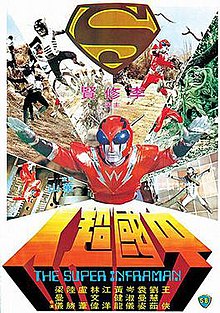|
Infra-Man
Infra-Man (Chinese: 中國超人, lit. Chinese Superman, also known as The Super Inframan)[1][2] is a 1975 Hong Kong superhero film directed by Hua Shan and produced by Runme Shaw. Produced and distributed by Shaw Brothers Studio, the film was inspired by the success of the Japanese tokusatsu franchise Kamen Rider that grew in popularity in Asian regions such as Taiwan, Hong Kong, and South Korea. Infra-Man was released theatrically in Hong Kong on August 1, 1975. PlotThe story recounts that in 2015, Demon Princess Elzebub (also translated as Princess Dragon Mom) awakens from 10 million years of dormancy and plots to conquer the Earth. She destroys a few major cities in China to prove her power, and humanity reacts in shock. Returning to her lair in Inner-Earth, she awakens her army of Skeleton Ghosts and various mutant humanoids to wreak havoc on the surface. In the story, the head of the Science Headquarters, Professor Liu Ying-de, has completed the BDX Project, a potential countermeasure against Elzebub. In the HQ's secret laboratory, he transforms Lei Ma, a high-ranking SH officer, into the bionic kung fu superhero Inframan. The solar-powered red-&-silver armored Inframan has both enhanced strength and combat weapons. Once Inframan destroys the Princess’s various monsters, she decides to steal the professor's blueprints of Inframan in hope of discovering his weakness. Meanwhile, the professor introduces Thunderball Fists, gloves capable of destroying any substance known to man, as well as covering up Inframan's weakness. Capturing the professor's daughter, the princess blackmails the professor into creating an Inframan for her. The professor agrees to go to Mount Devil for a meeting. When the professor refuses to make another Inframan, he and his daughter are frozen. Inframan and the Science Patrol decide to rescue both, leading to the final battle between Inframan and Demon Princess Elzebub. CastProtagonists
Antagonists
Ice Monsters (冰河怪獸)
ProductionThe film was directed by Hua Shan, written by science fiction writer Ni Kuang, produced by Runme Shaw and photographed by Tadashi Nishimoto. There was also assistance from Japan; music from Ultra Seven (1967) and Mirrorman (1971) (both composed by Toru Fuyuki) is used in this film and the Inframan/Science Headquarters/monster costumes were provided by Ekisu Productions, which had done costumes for many Toei superhero TV shows of the same period. The film also starred Danny Lee as the superhero himself, and Bruceploitation star Bruce Le in a supporting role (he still got to display some of his martial arts skills in many scenes of the film). The following year, Joseph Brenner brought this film to the U.S., and re-titled it simply Infra-Man (or Inframan), with the advertising campaign slogan "The Man Beyond Bionics!" attempting to capitalize upon The Six Million Dollar Man's success on American network television at the time. This film also has some historical importance as the first superhero film set in Hong Kong, the first film promotion in Hong Kong using a hot air balloon, and the first Shaw Brothers production using a storyboard. In 2004, the film was released on DVD in Japan and Hong Kong. ReceptionRoger Ebert, in his 7 March 1976 review for the Chicago Sun-Times, gave the film two and a half stars out of four, concluding "The movie even looks good: It's a classy, slick production by the Shaw Brothers, the Hong Kong kung fu kings. When they stop making movies like Infra-Man, a little light will go out of the world."[3] Infra-Man has an aggregated score of 100% based on six critic reviews on Rotten Tomatoes.[4] On 30 April 1999, after Quentin Tarantino re-released Mighty Peking Man in North America, Ebert upgraded his rating for the film to three stars, explaining that "I find to my astonishment that I gave Infra-Man only two and a half stars when I reviewed it. That was 22 years ago, but a fellow will remember a lot of things you wouldn't think he'd remember. I'll bet a month hasn't gone by since that I haven't thought of that film. I am awarding Mighty Peking Man three stars, for general goofiness and a certain level of insane genius, but I cannot in good conscience rate it higher than Infra-Man. So, in answer to those correspondents who ask if I have ever changed a rating on a movie: Yes, Infra-Man moves up to three stars."[5] The original review of the film as re-posted on Ebert's website accordingly gives the film three stars. VersionsThe film was released on VHS under both Prism Entertainment and Goodtimes Entertainment. In the Goodtimes Home Video version of the American opening credits, an additional section was added in between the title and the cast and crew from the Prism version, giving the film the subtitle "Battles The Sci-Fi Monsters" in an attempt to appeal more to fans of that titular genre. In this additional but misleading sequence, short snippets from the film are used to introduce and inaccurately name the villains of the film, with some villain characters cut out entirely. InfluenceElements from the film influenced the 2017 revival of Mystery Science Theater 3000. Producer Joel Hodgson explained in an interview that Princess Dragon Mom was one of the influences for the mad scientist Kinga Forrester and that the skeleton-like Henchmen influenced the boneheads, including The Skeleton Crew Band.[6] References
External links |
||||||||||||||||||||||||||||||||||||||||||||||||||||||||||
Portal di Ensiklopedia Dunia
